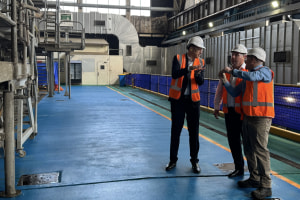Ice cream: it never gets old.
Kids and adults alike simply can’t get enough of the stuff – particularly on the fancier end of the market.
In a recent report for Rabobank, senior analyst Marc Soccio identified a 10 per cent increase in the demand for premium ice cream products, while standard brands dropped four per cent, and ‘healthy-choice’ options a massive 15 per cent.
It’s proof positive of the fact that while consumers are increasingly after high-quality products – for which they’re prepared to pay a premium – their desire to indulge their sweet tooth is continuing apace.
It’s a dynamic that’s seen Harry’s Ice Cream go from a single store to a major Australian business with international expansion on the cards.
Twenty years ago, Lawrence Harris and his brother David bought a retail store in Chadstone Shopping Centre, with a simple ice cream machine out back.
“It was a lot of run-of-the-mill flavours, but it was freshly made every day,” recalls Harris.
“At that time, to make that sort of ice cream in store, I don’t think was particularly common. It was relatively innovative.”

Over the next few years, Harry’s Ice Cream expanded to 12 company-owned stores in both Sydney and Melbourne, and, in 1999, set up a commercial manufacturing facility in the inner-city suburb of Brunswick.
By 2002, Harry’s was in the fortunate position to take over from a failed competitor, thus establishing a national distribution network that allowed the company to get out of retail and into commercial food production.
“When we went to commercial machines, the ice cream did have a different appearance, and was a risk,” says Harris.
“But at that stage we’d already made the decision that we were not going to continue in retail.
"And what we’ve always pushed as one of our selling points is that yes we do manufacture using commercial techniques but our background, where we came from, means we understand the benefits and what to use of those skills from the manufacturing-by-hand days.”
That artisanal philosophy, while an overused phrase, has stood Harry’s Ice Cream in good stead in an evolving food market.
“I think probably for want of a better word, ice cream has become more premium,” says Harris.
“We’re more interested in innovative flavours and the inclusions that we put in the ice cream, and there’s more interest in food in general with all the cooking shows, and that has helped, there’s no doubt.”
A focus on provenance has also helped the Harry’s brand, and many of their products use milk sourced from a family dairy.
“A family dairy is pretty unusual these days and the dairy is supported by the brothers who own their own dairy farms and decided to set up their own processing plant in Victoria.
"We can point to the fact that a lot of our cream and milk comes from that specific area of Victoria,” explains Harris.
“We’re pretty fortunate here in Australia, as we do have great raw ingredients – the basics – the cream, milk, and sugar and that’s a nice story in itself.”
It’s no secret, either, that Australian produce has a great name overseas, particularly in Asia.
With the help of the local Moreland City Council, in conjunction with the Victorian state government, Harris has been reaching out to international clientele.
“I must tell you, because I had a meeting yesterday with a potential overseas customer in conjunction with state government and my local council, and I think I can’t speak for everyone else, but for us the support has been really extraordinary,” says Harris.
With the strong demand for Harry’s product locally, and the potential growth in markets overseas, Harris is currently in the process of moving to a larger facility in Hadfield.
While the current manufacturing facility only allows for a single line to operate, the new facility will have the potential to run multiple lines concurrently.
“The new plant is considerably bigger volume and there’s more automation in it,” says Harris. “Obviously we’ve got to find somewhere to sell the product, but we will be able to produce in the same time period more than two and a half times the tonnage.”
While blast freezing facilities will be used in the new facility, a hardening-tunnel process will also be put into place, allowing product to be frozen before it’s palletised.
“With ice cream, in theory, when the product comes out of the ice cream machine it comes out at anywhere between -4 and -6 degrees depending on the product,” Harris explains.
"The faster you can then reduce it down to storage temperature, colder then -18, the better it is for the integrity of the product.
“It’s acceptable to freeze it overnight or in a five to eight hour period but if you can freeze it in 40 minutes it’s better again.”
Depending on agreements with international customers, there’s also the opportunity for Harry’s to invest in new machinery to produce different product lines for export.
“We’re looking at a number of different machines at the moment and some of it is linked in with a couple of potential customers overseas,” says Harris.
“That will dictate to some extent what we do with this new innovative machine, but it will be a dessert product, perhaps a layered dessert, perhaps some sort of variant like a sandwich where it’s different layers, rather than just ice cream in a tub.”

The company has around 20 full-time employees at the moment, but with current expansion plans, Harris expects his staff to double by the end of 2017.
But, if there’s any indicator of Harry’s Ice Cream’s success, it’s that after 20 years in the business, Harris’ family still wants to eat it.
“I’ve got three daughters, and they never get tired of me bringing ice cream home,” Harris says.
“Friday night often I’ll get a phone call before I leave asking what I'm bringing home: 'Will you bring this home, will you bring that home?'"
"I always agree.”






